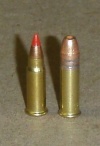Difference between revisions of ".17 HM2"
(→External links) |
(→External links) |
||
| Line 106: | Line 106: | ||
[[category:ammunition]] | [[category:ammunition]] | ||
[[Category:.17]] | [[Category:.17]] | ||
| − | [[Category:Rimfire]] | + | [[Category:Rimfire cartridges]] |
Revision as of 13:02, 21 July 2015
| .17 HM2 Cartridge | .17 HM2 Ballistics tables | Cartridges |
| .17 Hornady Mach 2 | ||||||||||
|---|---|---|---|---|---|---|---|---|---|---|

| ||||||||||
| Left: .17 HM2, Right: .17 HMR | ||||||||||
| Type | Rimfire | |||||||||
| Country of Origin | USA | |||||||||
| Specifications | ||||||||||
| Parent Case | .22 Long Rifle | |||||||||
| Bullet Ø | .172 in (4.4 mm) | |||||||||
| Neck Ø | .180 in (4.6 mm) | |||||||||
| Shoulder Ø | .226 in (5.7 mm) | |||||||||
| Base Ø | .226 in (5.7 mm) | |||||||||
| Rim Ø | .275 in (7.0 mm) | |||||||||
| Case Length | .714 in (18.1 mm) | |||||||||
| Full Length | 1.00 in (25 mm) | |||||||||
| Primer | rimfire | |||||||||
| Production & Service | ||||||||||
| Designer | Hornady | |||||||||
| Design Date | 2004 | |||||||||
| Manufacturer | CCI/Hornady/Eley | |||||||||
| Production Dates | 2004-present | |||||||||
| Ballistic Performance Sampling | ||||||||||
| ||||||||||
Contents |
Performance
The ultralight bullet is a key part of achieving the very-high velocity for a rimfire round. It weighs only 17 grains (1.10 g) vs 30-40 grains (1.94-2.59 g) for typical .22 LR bullets. The .17 HM2 may or may not live up to its "Mach 2" name, depending on geographic location and conditions, with velocities out of a rifle of 2100 ft/s (640 m/s). The velocity is nearly double that of a standard .22 LR, which results in a much flatter trajectory out to the 175 yards (160 m) effective range of the cartridge.
Costs
The tiny .17 caliber jacketed bullet is much more difficult to manufacture than the copper-coated lead .22 LR bullets, and that is reflected in the cost — typically twice that of inexpensive .22 Long Rifle ammunition. The price is still less than any surplus centerfire ammunition, and less than the more powerful .17 HMR. The high priced bullet used in the .17 HM2 does have advantages, including accuracy.
Converting rifles
Since the .17 HM2 is based on the .22 Long Rifle converting most bolt action firearms chambered in .22 Long Rifle to .17 HM2 requires only a barrel change. The higher pressure makes conversion of semi-automatic firearms more difficult, as virtually all are blowback designs that are sensitive to pressure changes. Kits for the Ruger 10/22 and AR-15 platform have appeared, and they replace the factory bolt or bolt handle with a heavier one to increase the bolt mass and compensate for the higher pressure. Since the .22 Long Rifle is arguably the most popular cartridge in the world, the .17 HM2 has a large pool of firearms that could potentially chamber it.[2]
Market acceptance
The .17 HMR was an instant success when it came out, but the .17 HM2 hasn't gained as much acceptance. Part of the .17 HMR's success may have been due simply to the uniqueness of the first mass-manufactured .17 caliber rimfire, or the fact that .17 HMR is very versatile and is well suited for varmint hunting. The .17 HM2 must compete with .22LR, and as such, has not captured a significant portion of the varmint-caliber shooting market. Ammunition is made by Eley, Hornady, and CCI. Few rifles are currently offered in .17 HM2, and many conversion parts are no longer available. While many people still shoot "Mach 2", overall the .17 HM2 is not considered successful.
Specifications
See also
References
External links
- "The .17 HM2" by Chuck Hawks
- Eley
- CCI


